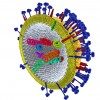Update Catching the Flu: Between Complacency and Fear

A model of the influenza virus. (Artwork by Holger Guggi, copyright by Reingard Grabherr and Florian Krammer.)
Back in January, I blogged about how in December of 2011 the U.S. National Science Advisory Board for Biosecurity (NSABB) took the controversial step of requesting that the high-impact journals Science and Nature remove certain methodological details and the identity of the key mutations from the results to be published of two H5N1 avian influenza virus studies. The reason for this drastic regulation? The NSABB classified their results as “dual use” research – research that could be used for either beneficial or ill-purposed applications. They raised concerns about the studies because of the possibility that the methods could potentially be used by bioterrorists to engineer a version of avian influenza that is transmissible from human to human and might be subsequently pandemic.
In the U.S. the NSABB began evaluating the threat to national security or public health compared to the potential benefit of the research. Nature and Science both agreed to consider the NSABB recommendation to edit the papers with methodological key sections withheld.
The NSABB intervention raised the conflict of academic freedom in influenza research versus the risk of an accidental or intentional outbreak of the changed H5N1 strains. Since then, there has been lively debate in the scientific community and among public health, biosecurity, and government representatives.
How should dual research being defined? How dangerous is this type of research? What types of experiments should be identified as “potentially dangerous” to public health? Given that “dual use” is a broad concept, is the reaction of the people involved likely to be a one-time exception, or is this becoming a common pattern?
And what is the value of research that cannot be published?
In addition, the controversy has provoked discussion of the likelihood of the virus developing the capacity for human-to-human transmission via a natural process, without the aid of artificial genetic manipulation. Also, the fact that a virus can spread easily among ferrets as a prediction for a human model is not guaranteed; that is impossible to prove or disprove because lab-made viruses will not be tested in people.
In response to the controversy, 39 influenza researchers announced a self-imposed 60-day moratorium on all further work into what might make H5N1 viruses more transmissible among humans. The moratorium will run out in March 2012. This time will allow defined stakeholders to debate the best solutions for the current proceedings and to develop polices to prevent similar disagreements in the future.
The moratorium also enabled a meeting of 22 international influenza and public health experts in February at the World Health Organization (WHO) headquarters in Geneva, to discuss the studies and make recommendations concerning free flow of data and materials to researchers around the world.
The majority of the meeting attendees concluded that the two controversial flu papers should be published in full. However the timeline for publication is now delayed while the relevant parties determine the details of the process and discuss the appropriate biosecurity and biosafety conditions for future studies and the importance of explanations to the public.
Hopefully the apparently wide gap between research scientists and bioterrorism policy analysts can be closed soon. In the meantime the scientific community awaits the most famous, unpublished scientific paper.
Further information
Peter Palese
Palese P, Wang TT. H5N1 influenza viruses: facts, not fear. Proc. Natl. Acad. Sci. USA 2012;109(7):2211-2213.
Michael T. Osterholm
Osterholm MT, Henderson DA. Life sciences at a crossroads: respiratory transmissible H5N1. Science 2012.
Vincent R. Racaniello
Racaniello VR. Science should be in the public domain. MBio 2012;3(1).
Genereal information to dual-use research, public health and biosecurity
Faden RR, Karron RA. The Obligation to Prevent the Next Dual-Use Controversy. Science. 2012;335(6070):802-804.
Fidler DP, Gostin LO. The WHO pandemic influenza preparedness framework: a milestone in global governance for health. JAMA. 2011;306(2):200-201.
Berns KI, Casadevall A, Cohen ML, et al. Policy: Adaptations of avian flu virus are a cause for concern. Nature 2012;482(7384):153-154.
Berns KI, Casadevall A, Cohen ML, et al. Public health and biosecurity. Adaptations of avian flu virus are a cause for concern. Science 2012;335(6069):660-661.
Facing up to flu. Nature. 2012;482(7384):131-131.
Link to he full video coverage of February´s panel discussion Dual Use Research: H5N1 Influenza Virus and Beyond symposium at the NYAS.
http://www.nyas.org/MemberCenter/AcademyNews.aspx?cid=8c61a204-36f6-4df8-8bd2-059882c5e287
The panel discussion featured the moderator W. Ian Lipkin, MD (Columbia University) and the panelists Arturo Casadevall, MD, PhD (Albert Einstein College of Medicine; Member, NSABB); Laurie Garrett, PhD (Council on Foreign Relations); Barbara R. Jasny, PhD (Science); Véronique Kiermer, PhD (Nature Publishing Group); Michael T. Osterholm, PhD, MPH (University of Minnesota; Member, NSABB); Peter Palese, PhD (Mount Sinai School of Medicine); Vincent Racaniello, PhD (Columbia University) and Alan S. Rudolph, PhD (Defense Threat Reduction Agency).
| Print article | This entry was posted by Christine Marizzi on February 29, 2012 at 3:56 pm, and is filed under G2C Online. Follow any responses to this post through RSS 2.0. You can leave a response or trackback from your own site. |


